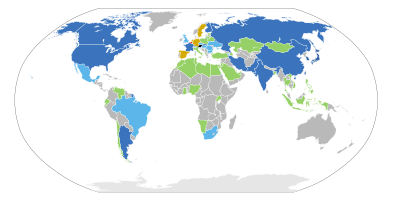Nuclear power in France
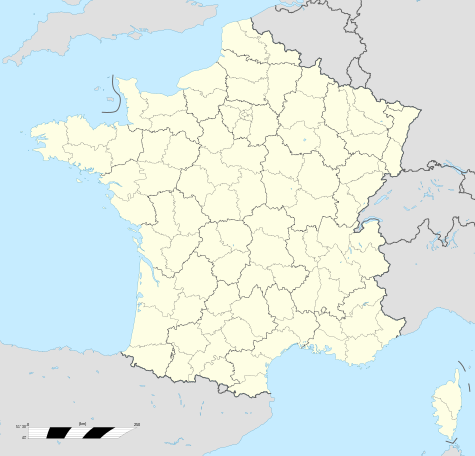
Superphénix
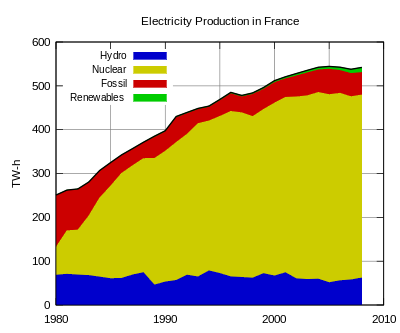
Nuclear power is the primary source of electricity in France. In 2004, 425.8 TWh out of the country's total production of 540.6 TWh of electricity was from nuclear power (78.8%), the highest percentage in the world.[1].
France is also the world's largest net exporter of electric power, exporting 18% of its total production (about 100 TWh) to Italy, the Netherlands, Belgium, Britain, and Germany, and its electricity cost is among the lowest in Europe.[1][2] France's nuclear power industry has been called "a success story" that has put the nation "ahead of the world" in terms of providing cheap, clean energy.[3] However, France's nuclear reactors are mainly used in load-following mode and some reactors close on weekends because there is no market for the electricity.[4][5] This means that the capacity factor is low by world standards, which is not an ideal economic situation for nuclear plants.[4]
As of 2002, Électricité de France (EDF) — the country's main electricity generation and distribution company — manages the country's 59 nuclear power plants. As of 2008[update], these plants produce 90% of EDF's and about 78% France's electrical power production (of which some is exported),[4] making EDF the world leader in production of nuclear power by percentage.
In 2006, the French Government asked Areva and EDF to build a next generation nuclear reactor, the EPR (European Pressurized Reactor), at the Flamanville Nuclear Power Plant. This was followed in 2008 by a Presidential announcement of another new EPR, spurred by high oil and gas prices.[6] A site for that unit should be selected in 2009, and construction should start in 2011.
Contents |
History
France has a long relationship with nuclear power, starting with Henri Becquerel's discovery of natural radioactivity in the 1890s and continued by famous nuclear scientists like Pierre and Marie Curie.
Before World War II, France had been heavily involved in nuclear research through the work of the Joliot-Curies. In 1945 the Provisional Government of the French Republic (GPRF) created the Commissariat à l'Énergie Atomique (CEA) governmental agency, and Nobel prize winner Frédéric Joliot-Curie, member of the French Communist Party (PCF) since 1942, was appointed high-commissioner. He was relieved of his duties in 1950 for political reasons, and would be one of the 11 signatories to the Russell-Einstein Manifesto in 1955.
The CEA was created by Charles de Gaulle on October 18, 1945. Its mandate is to conduct fundamental and applied research into many areas, including the design of nuclear reactors, the manufacturing of integrated circuits, the use of radionucleides for medical treatments, seismology and tsunami propagation, and the safety of computerized systems.
Nuclear research was discontinued for a time after the war because of the instability of the Fourth Republic and the lack of finances available.[7] However, in the 1950s a civil nuclear research program was started, a byproduct of which would be plutonium. In 1956 a secret Committee for the Military Applications of Atomic Energy was formed and a development program for delivery vehicles started. In 1957, soon after the Suez Crisis and the diplomatic tension with both the USSR and the United States, French president René Coty decided the creation of the C.S.E.M. in the then French Sahara, a new nuclear tests facility replacing the C.I.E.E.S.[8] See France and nuclear weapons.
The first French power plant was opened in 1965.
In 2001, Areva, the world leading company in nuclear energy, was created by the merger of CEA Industrie, Framatome and Cogema (now Areva NC). Its main shareholder is the French owned company CEA, but the German government also holds, through Siemens, 34% of the shares of Areva's subsidiary, Areva NP, in charge of building the EPR (third-generation nuclear reactor).[9]
Technical overview
Drawing such a large percentage of overall electrical production from nuclear power is unique to France. This reliance has resulted in certain necessary deviations from the standard design and function of other nuclear power programs. For instance, in order to meet changing demand throughout the day, some plants must work as peaking power plant, whereas most nuclear plants in the world operate as base load plants, and allow other fossil or hydro units to adjust to demand. Nuclear power in France has a total capacity factor of around 77%, which is low due to load following. However availability is around 84%, indicating excellent overall performance of the plants.
The first 8 power reactors in the nation were gas cooled reactor types (UNGG reactor), whose development was pioneered by CEA. Coinciding with a uranium enrichment program, EdF developed pressurized water reactor (PWR) technology which eventually became the dominant type. The gas-cooled reactors located at Brennilis, Bugey, Chinon, and Marcoule have all been shut down.
All operating plants today are PWRs with the exception of the Phénix, which was part of an initiative to develop sodium-cooled fast breeder reactor technology. The Superphénix, a larger, more ambitious version, has been shut down.
The PWR plants were all developed by Framatome (which is now Areva) from the initial Westinghouse design . All of the PWR plants are one of three variations of the design, having output powers of 900 MWe, 1300 MWe, and 1450 MWe. The repeated use of these standard variants of a design has afforded France the greatest degree of nuclear plant standardization in the world.
900 MWe class
There are a total of 34 of these reactors in operation; most were constructed in the 1970s and the early 1980s. In 2002 they had a uniform review and all were granted a 10 year life extension.
This three loop design (three steam generators and three primary circulation pumps) was also exported to a number of other countries, including:
- South Africa - 2 units at the Koeberg nuclear power station
- South Korea - 2 units at the Ulchin Nuclear Power Plant
- Peoples' Republic of China
- 2 units at the Daya Bay Nuclear Power Plant
- 4 units at the Ling Ao Nuclear Power Plant (2 units under construction)
- 2 units at the Hongyanhe Nuclear Power Plant (under construction)
- 1 unit at the Ningde Nuclear Power Plant (under construction)
1300 MWe class
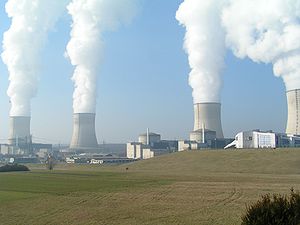
There are 20 reactors of this design (four steam generators and four primary circulation pumps) operating in France.
1450 MWe (N4) class
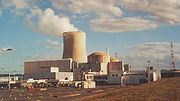
There are only 4 of these reactors, housed at two separate sites: Civaux and Chooz. Construction of these reactors started between 1984 and 1991, but full commercial operation did not begin until between 2000 and 2002 because of thermal fatigue flaws in the heat removal system requiring the redesign and replacement of parts in each N4 power station.[10] In 2003 the stations were all uprated to 1500 MWe. It is unlikely that more of this class will be built because it is expected to be succeeded by the larger 1650 MWe EPR design.
European Pressurized Reactor
The next generation design for French reactors will be the European Pressurized Reactor (EPR), which will have a broader scope than just France with a pilot plant in Finland undergoing construction and with marketing activities extending to the United States and China. The site for first French EPR is undergoing groundwork at the Flamanville Nuclear Power Plant, which should be operational in 2012.
This reactor is one of the newest reactor designs in the world. It was developed by Areva contributing its N4 reactor technology and the German company Siemens contributing its Konvoi reactor technology. Keeping with the French rationale of a highly standardized plant and proven technology, it uses more traditional active safety systems and is more similar to current plant designs than international competitors such as the AP1000 or the ESBWR.
In 2005 EdF announced plans to replace the current nuclear plants with new 1600 MWe units as they reach the end of their licensed life, starting around 2020. This decisions confirms that France will continue indefinitely to use nuclear power as its primary electricity source. In order to replace the current 58 reactors, one new large unit will have to be built about every year for about 40 years.
Fusion reactors
While fusion power is not expected to be feasible for many more decades, France has shown promise to be a forerunner in the technology by winning the bid to host the ITER reactor in Cadarache.[11] The ITER should start actual fusion around 2018. However, ITER does not plan to generate any commercially available energy. Instead the construction of another plant, named DEMO, will test the feasibility of commercial Fusion, before they are added to the energy supply.
Cooling
The majority of nuclear plants in France are located away from the sea coasts and obtain their cooling water from rivers. These plants employ cooling towers to reduce their impact on the environment. The temperature of emitted water carrying the waste heat is strictly limited by the French government, and this has proved to be problematic during recent heat waves.[12]
4 plants, equaling 14 reactors are located on the coast:
- Gravelines Nuclear Power Plant
- Penly Nuclear Power Plant
- Paluel Nuclear Power Plant
- Flamanville Nuclear Power Plant
These 4 get their cooling water directly from the ocean and can thus dump their waste heat directly back into the sea, which is slightly more economical.
Fuel cycle
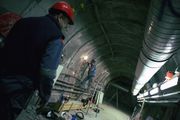
France is one of the few countries in the world with an active nuclear reprocessing program, with the COGEMA La Hague site. Enrichment work, some MOX fuel fabrication, and other activities take place at the Tricastin Nuclear Power Center. Enrichment is completely domestic and is powered by 2/3rds of the output of the nuclear plant at Tricastin. Reprocessing of fuel from other countries has been done for the United States and Japan, who have expressed the desire to develop a more closed fuel cycle similar to what France has achieved. MOX fuel fabrication services have also been sold to other countries, notably to the USA for the Megatons to Megawatts Program, using Plutonium from dismantled nuclear weapons.
While France does not mine Uranium for the front end of the fuel cycle domestically, French companies have various holdings in the Uranium market. Uranium for the French program totals 10,500 tonnes per year coming from various locations such as:
- Canada - 4500 tU/yr
- Niger - 3200 tU/yr
Final disposal of the high level nuclear waste is planned to be done at the Meuse/Haute Marne Underground Research Laboratory deep geological repository.
Accidents and incidents
| Date | Location | Description | Cost (in millions 2006 US$) |
|---|---|---|---|
| 25 July 1979 | Saclay, France | Radioactive fluids escape into drains designed for ordinary wastes, seeping into the local watershed at the Saclay BL3 Reactor | 5 |
| 13 March 1980 | Loir-et-Cher, France | A malfunctioning cooling system fuses fuel elements together at the Saint Laurent A2 reactor, ruining the fuel assembly and forcing an extended shutdown | 22 |
| 14 April 1984 | Bugey, France | Electrical cables fail at the command centre of the Bugey Nuclear Power Plant and force a complete shutdown of one reactor | 2 |
| 22 May 1986 | Normandy, France | A reprocessing plant at Le Hague malfunctions and exposes workers to unsafe levels of radiation and forces five to be hospitalised | 5 |
| 12 April 1987 | Tricastin, France | Tricastin fast breeder reactor leaks coolant, sodium and uranium hexachloride, injuring seven workers and contaminating water supplies | 50 |
| 27 December 1999 | Blayais, France | An unexpectedly strong storm floods the Blayais-2 nuclear reactor, forcing an emergency shutdown after injection pumps and containment safety systems fail from water damage | 55 |
| 21 January 2002 | Manche, France | Control systems and safety valves fail after improper installation of condensers, forcing a two-month shutdown | 102 |
| 16 May 2005 | Lorraine, France | Sub-standard electrical cables at the Cattenon-2 nuclear reactor cause a fire in an electricity funnel, damaging safety systems | 12 |
| 13 July 2008 | Tricastin, France | Dozens of litres of wastewater contaminated with uranium are accidentally poured on the ground and runoff into a nearby river | 7 |
| 12 August 2009 | Gravelines, France | Assembly system fails to properly eject spent fuel rods from the Gravelines Nuclear Power Plant, causing the fuel rods to jam and the reactor to shut down | 2 |
In July 2008, 18,000 litres (4,755 gallons) of uranium solution containing natural uranium were accidentally released from Tricastin Nuclear Power Center. Due to cleaning and repair work the containment system for a uranium solution holding tank was not functional when the tank filled. The inflow exceeded the tank's capacity and 30 cubic meters of uranium solution leaked, with 18 cubic meters spilled on the ground. Testing found elevated uranium levels in the nearby Gaffière and Lauzon rivers. The liquid that escaped to the ground contained about 75 kg of natural uranium, which is toxic as a heavy metal, but only slightly radioactive. Estimates for the releases were initially higher, up to 360 kg of natural uranium, but revised downward later.[15] French authorities banned the use of water from the Gaffière and Lauzon for drinking and watering of crops for 2 weeks. Swimming, water sports and fishing were also banned. This incident has been classified as Level 1 (anomaly) on the International Nuclear Event Scale.[16]
Shortly after the first incident, approximately 100 employees were exposed to minor doses of radiation (1/40 of the annual limit) due to a piping failure.[17]
More incidents have occurred, also recently. For that, see the page of each individual nuclear plant.
Limitations
France's nuclear reactors comprise 90 per cent of EDFs capacity and so they are used in load-following mode and some reactors close on weekends because there is no market for the electricity.[4][5] This means that the capacity factor is low by world standards, usually in the high seventies as a percentage. This is not an ideal economic situation for nuclear plants, but is required due to the load following nature of some reactors.[4]
During periods of high demand EDF has been routinely "forced into the relatively expensive spot and short-term power markets because it lacks adequate peak load generating capacity".[5]
All but four of EDFs plants are inland and require fresh water for cooling. Eleven of these 15 inland plants have cooling towers, using evaporative cooling, while the others user lake or river water directly. So in very hot summers, generation output may be restricted.[4]
It is sometimes said that nuclear power in France has reduced the country's dependence on oil for electricity generation. While this is true for the electricity generation sector, about 70 per cent of the total energy consumed in France during 2006 was still from fossil fuels.[5] Most of that energy is consumed in the transportation sector where nuclear power cannot be used directly.
It has also been suggested that France has over-invested in nuclear, which has meant that underpriced electricity has been exported to other countries or "dumped" on the French market, encouraging the use of electrcity for space heating and water heating. This can be regarded as an environmentally wasteful practice.[4] On the other hand, this practice reduces the need to use natural gas or other fossil fuels for space and water heating. Even if they are more efficient for those uses, using them would still contribute to greenhouse gases emissions.
Public opinion
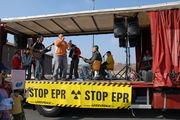
Historically, nuclear power was supported by the Gaullists, the Socialist Party and the Communist Party. However, a 2006 BBC / GlobeScan poll found that 57% of the French population were opposed to nuclear energy in France.[18] This contrasts with earlier reports, when the construction of the Civaux Nuclear Power Plant was claimed to be welcomed by the local community in 1997:
In France, unlike in America, nuclear energy is accepted, even popular. Everybody I spoke to in Civaux loves the fact their region was chosen. The nuclear plant has brought jobs and prosperity to the area. Nobody I spoke to, nobody, expressed any fear.[19]
A variety of reasons are cited for the popular support; a sense of national independence and reduced reliance on foreign oil, reduction of greenhouse gases, and a cultural interest in large technological projects (like the TGV and Concorde).[19][20]
At the time of the 1973 oil crisis, most of France's electricity came from foreign oil. While France was strong in heavy engineering capabilities, it had few indigenous energy resources,[2] so the French government decided to invest heavily in nuclear power, and France installed 56 reactors over the next 15 years.[19] President of Electricite de France Laurent Striker said, "France chose nuclear because we have no oil, gas or coal resources, and recent events have only reinforced the wisdom of our choice".[21]
Areva NC claims that, due to their reliance on nuclear power, France's carbon emissions per kWh are less than 1/10 that of Germany and the UK, and 1/13 that of Denmark, which has no nuclear plants. Its emissions of nitrogen oxide and sulfur dioxide have been reduced by 70% over 20 years, even though the total power output has tripled in that time.[22] In the same Ipsos poll, 88 percent of the population believe that reducing the greenhouse effect was a major reason to continue using nuclear power.[23] French environmentalist Bruno Comby started the group Environmentalists For Nuclear Energy, and says, "If well-managed, nuclear energy is very clean, does not create polluting gases in the atmosphere, produces very little waste and does not contribute to the greenhouse effect".[24]
Various anti-nuclear movements have appeared over the years, starting with the emergence of the environmentalist movement in the 1970s which opposed the creation of the Superphénix nuclear power station, culminating in a rocket attack on the containment building in 1982. In June 1997, one of the first actions of socialist Lionel Jospin on becoming Prime Minister was to announce the closure of the plant "because of its excessive costs", in accordance to electoral deals with the The Greens, created in the beginning of the 1980s. After the 1986 Chernobyl catastrophe, the network Sortir du nucléaire (Nuclear phase-out) was also created. Greenpeace has consistently opposed the use of nuclear power, and has been campaigning since 1997 for the shutdown of La Hague reprocessing site.
See also
- List of nuclear reactors#France
- Politics of France
- Nuclear energy policy
- Anti-nuclear movement in France
- Death of Sebastien Briat
- Companies
- Électricité de France (EdF)
- Commissariat à l'Energie Atomique (CEA)
References
- ↑ 1.0 1.1 EnerPub (2007-06-08). "France: Energy profile". Spero News. http://www.speroforum.com/site/article.asp?idarticle=9839&t=France%3A+Energy+profile. Retrieved 2007-08-25.
- ↑ 2.0 2.1 World Nuclear Association (August 2007). "Nuclear Power in France". http://www.world-nuclear.org/info/inf40.htm. Retrieved 2007-08-25. (alternate copy)
- ↑ http://www.theledger.com/article/20080814/COLUMNISTS/808140356
- ↑ 4.0 4.1 4.2 4.3 4.4 4.5 4.6 Steve Kidd. Nuclear in France - what did they get right? Nuclear Engineering International, June 22, 2009.
- ↑ 5.0 5.1 5.2 5.3 Stephanie Cooke (2009). In Mortal Hands: A Cautionary History of the Nuclear Age, Black Inc., p. 359.
- ↑ "Second new reactor for France". World Nuclear News. 3 July 2008. http://www.world-nuclear-news.org/NN_Second_new_reactor_for_France_0307082.html. Retrieved 2009-07-10.
- ↑ Notice on France on Global Security (English)
- ↑ Sahara on the website of the French Minister of Defence (French)
- ↑ Lomazzi, Marc (13 August 2007). "Nucléaire: les dessous de l'accord entre la France et la Libye" (in (French)). Le Parisien. http://www.leparisien.fr/search/article.html?ID=DISPLAY1_0&index=1&DI_INDEX=1&docid=0708138285886.xml@LPA&titre='Nucl%E9aire%20:%20les%20dessous%20de%20l%20accord%20entre%20la%20France%20et%20la%20Libye.
- ↑ "Facts about Olkiluoto 3 financing". olkiluoto.info. http://www.olkiluoto.info/en/13/3/74/. Retrieved 2009-07-10.
- ↑ "ITER nuclear fusion reactor to be built in Southern France". PHYSORG. 28 Juin 2005. http://www.physorg.com/news4786.html.
- ↑ Robin Pagnamenta (3 July 2009). "France imports UK electricity as plants shut". London: The Times. http://business.timesonline.co.uk/tol/business/industry_sectors/utilities/article6626811.ece. Retrieved 2009-07-10.
- ↑ Benjamin K. Sovacool. A Critical Evaluation of Nuclear Power and Renewable Electricity in Asia, Journal of Contemporary Asia, Vol. 40, No. 3, August 2010, pp. 393–400.
- ↑ Benjamin K. Sovacool (2009). The Accidental Century - Prominent Energy Accidents in the Last 100 Years
- ↑ Angelique Chrisafis (10-7-2008). "River use banned after French uranium leak". London: The Guardian. http://www.guardian.co.uk/environment/2008/jul/10/nuclearpower.pollution. Retrieved 10-7-2008.
- ↑ "France bans water consumption over nuclear leak". 2008-07-09. http://www.expatica.com/fr/articles/news/France-bans-water-consumption-over-nuclear-leak.html. Retrieved 2008-07-24.
- ↑ Samuel, Henry (2008-07-24). "French nuclear leak prompts urgent security review". London: Telegraph.co.uk. http://www.telegraph.co.uk/news/worldnews/europe/france/2454654/French-nuclear-leak-prompts-urgent-security-review.html. Retrieved 2009-11-01.
- ↑ "BBC World Service Poll". http://www.globescan.com/news_archives/bbcwsenergy/. Retrieved 2010-04-28.
- ↑ 19.0 19.1 19.2 Palfreman, Jon (1997). "Why the French Like Nuclear Energy". Frontline (Public Broadcasting Service). http://www.pbs.org/wgbh/pages/frontline/shows/reaction/readings/french.html. Retrieved 2007-08-25.
- ↑ Rene de Preneuf. "Nuclear Power in France — Why does it Work?". http://www.npcil.nic.in/nupower_vol13_2/npfr_.htm. Retrieved 2007-08-25.
- ↑ "France Presses Ahead with Nuclear Power". Eleanor Beardsley (Reporter). Morning Edition. National Public Radio. Transcript. Retrieved on 2007-08-25.
- ↑ "Nuclear energy and the green house effect". AREVA NC. http://www.areva-nc.com/servlet/ContentServer?pagename=cogema_en%2FPage%2Fpage_html_libre_full_template&c=Page&cid=1042823465548. Retrieved 2007-08-25.
- ↑ "Nuclear Notes from France Nº70". Embassy of France. http://www.ambafrance-us.org/intheus/nuclear/n2f2/summer2001.asp. Retrieved 2007-08-25.
- ↑ "France's nuclear response to Kyoto". BBC. 2005-02-18. http://news.bbc.co.uk/1/hi/world/europe/4276461.stm. Retrieved 2007-08-25.
External links
- French Nuclear Power Program by the World Nuclear Association
- The reality of France's aggressive nuclear power push in Bulletin of the Atomic Scientists
|
||||||||||||||||||||||
|
||||||||||||||||||||||||||
